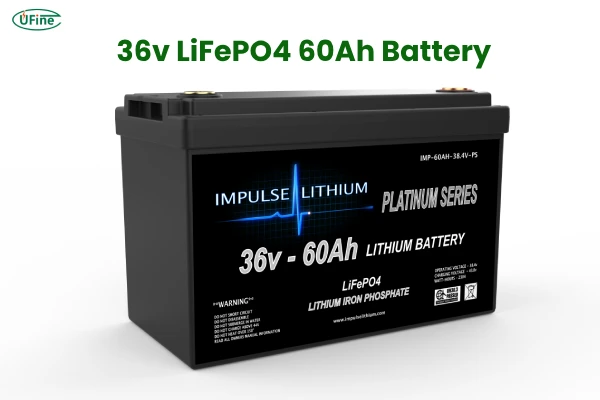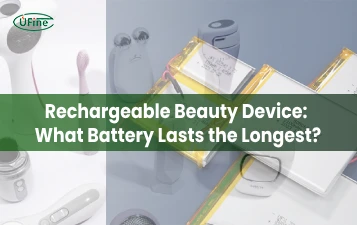Upgrading to a 60Ah lithium battery isn’t just a purchase—it’s an investment in efficiency, longevity, and performance. But with so many options, how do you make the right choice? This guide dives deep into lithium battery technology, helping you understand why a 60Ah LiFePO4 battery outperforms lead-acid, how to calculate its lifespan, and what factors matter most when selecting one.
Part 1. Lithium battery vs. LiFePO4: What’s the difference?

Not all lithium batteries are created equal. The two most common types are:
-
Standard Lithium-Ion (Li-ion): Found in smartphones and laptops, these batteries are lightweight and energy-dense but can be unstable under high stress. They degrade faster and pose a higher risk of overheating.
-
Lithium Iron Phosphate (LiFePO4): A safer, more stable alternative, LiFePO4 batteries offer 2,000+ charge cycles, minimal heat generation, and a lifespan 5x longer than lead-acid batteries. They’re ideal for deep-cycle applications like solar storage, RVs, and marine use 7.
Why LiFePO4 Wins:
✔ Thermal Stability – Unlike Li-ion, LiFePO4 doesn’t overheat, reducing fire risks.
✔ Longevity – Lasts 10+ years with proper care, compared to 3-5 years for lead-acid.
✔ Efficiency – Delivers 80-100% usable capacity, while lead-acid only provides 50% before performance drops.
Part 2. Why upgrade from lead-acid to a 60Ah LiFePO4 battery?
If you’re still using lead-acid, you’re missing out. Here’s why 60Ah LiFePO4 is the future:
✔ Longer Lifespan (2,000+ Cycles vs. 500 for Lead-Acid)
Lead-acid batteries degrade quickly, especially when deeply discharged. A 60Ah LiFePO4 battery handles 80-100% discharge daily without damage, making it perfect for off-grid solar or RV use 7.
✔ Lighter Weight (Half the Heft of Lead-Acid)
A 60Ah lead-acid battery weighs 18-22 kg, while a LiFePO4 equivalent is just 8-10 kg—crucial for RVs, boats, and portable power setups.
✔ Faster Charging (5x Quicker, No Memory Effect)
Lead-acid batteries charge slowly (8-10 hours). A 60Ah LiFePO4 battery can recharge in 2-3 hours at 0.5C (30A), with no memory effect—meaning partial charges won’t harm it 2.
✔ Zero Maintenance (No Water Refills, No Acid Leaks!)
Lead-acid requires regular topping up and careful voltage monitoring. LiFePO4 is completely sealed, requiring no maintenance—just plug and play.
A Comparative Analysis of LiFePO4 vs. Lead Acid
Part 3. What is a deep cycle lithium battery?
A deep-cycle battery is designed for long, steady discharges, unlike starter batteries that provide short bursts of power. A 60Ah deep-cycle lithium battery is perfect for:
-
Solar energy storage (daily charge/discharge cycles)
-
RV & marine use (running fridges, lights, and inverters)
-
Off-grid power systems (backup energy for homes)
-
Electric trolling motors (longer runtime than lead-acid)
Unlike lead-acid, a 60Ah LiFePO4 battery can be discharged to 80-100% without damage, giving you more usable energy per cycle 7.
Part 4. How long will a 60Ah lithium battery last?
Wondering how long a 60Ah battery will power your device? Here’s the exact formula:
Battery Life (Hours) = Battery Capacity (Ah) ÷ Device Load (A)
Example Scenarios:
-
12V Fridge (5A draw):
60Ah ÷ 5A = 12 hours (at full discharge)
(Realistically, 9-10 hours at 80% discharge for longevity.) -
LED Lights (2A total draw):
60Ah ÷ 2A = 30 hours (ideal for camping) -
Trolling Motor (20A draw):
60Ah ÷ 20A = 3 hours (but LiFePO4 handles deep discharges better than lead-acid)
Pro Tip: To maximize lifespan, avoid full 100% discharges daily. Keeping discharge between 20-80% can double your battery’s life 7.
Part 5. Is a 60Ah battery right for your device?
Choosing the right capacity isn’t guesswork — it’s a simple calculation based on your needs.
Ask yourself:
What is the power draw of my device?
How long do I need it to run between charges?
Do I have space and weight limitations?
For light to medium energy users — like in camping, small solar setups, or small electric vehicles — a 60Ah lithium battery is often just right.
If you’re running large air conditioners, high-power appliances, or bigger trolling motors, you might want to consider linking two batteries or stepping up to 100Ah or more.
A 60Ah lithium battery is ideal for:
- Small to medium RVs (running lights, fridge, fans for 1-2 days)
Solar power banks (1-2 kWh storage for essential loads) - Marine applications (trolling motors, fish finders, bilge pumps)
- Electric scooters/bikes (extended range with lightweight power)
Need more capacity?
-
100Ah+ for larger RVs or off-grid homes.
-
20-30Ah for small gadgets or backup power.
And don’t forget — with Ufine Battery, you can customize your lithium battery to fit your exact needs!
Part 6. 12V, 24V, 36V, or 48V? How to choose?
Your battery must match your system voltage:
-
12V – Best for RVs, boats, small solar setups.
-
24V – More efficient for larger solar systems, reducing current draw.
-
36V/48V – High-power applications (golf carts, large solar arrays).
A 12V 60Ah LiFePO4 battery is the most versatile for everyday use.
Higher voltage means fewer amps for the same power output — making your system more efficient. Not sure which one fits your setup? Ufine Battery’s experts can help design the perfect voltage and capacity combination for you.
Part 7. Signs you need to upgrade battery
Time to ditch lead-acid if:
- Your battery dies too fast (won’t hold a charge).
- You need more power (longer runtime between charges).
- Overheating issues (LiFePO4 runs cooler).
- Tired of maintenance (no more acid leaks or water refills!).
Part 8. Charger selection
Not all chargers work with LiFePO4! Look for:
- LiFePO4-compatible (avoid lead-acid chargers).
- Smart charging (auto-cutoff at full charge).
- Correct voltage (match your battery’s system).
Best charging current:
-
0.5C (30A) for fast charging (~2 hours).
-
0.2C (12A) for gentle, long-life charging (~5 hours).
Part 9. Price & brand
A 60Ah LiFePO4 battery costs 800, depending on:
-
Brand reputation (Renogy, Battle Born, Ufine Battery).
-
Features (built-in BMS, Bluetooth monitoring).
-
Warranty (5+ years is ideal).
Why Choose Ufine Battery?
As a leading Chinese lithium battery manufacturer, Ufine Battery specializes in custom lithium polymer, LiFePO4, and 18650 batteries. Whether you need ultra-thin, high-rate, or high-temperature lithium batteries, Ufine offers tailored solutions for your exact needs.
Custom options include:
✔ Different sizes, voltages, and capacities
✔ High-discharge batteries for power-hungry devices
✔ Extreme-temperature batteries for harsh environments
Contact Ufine Battery today for a personalized battery solution!
Part 10. Maintenance & care tips for maximum lifespan
LiFePO4 batteries last 10+ years with proper care:
- Avoid extreme temps (store between -20°C to 60°C).
- Don’t fully discharge often (keep above 20%).
- Use a compatible charger (prevents damage).
- Store at 50% charge if unused for months.
Part 11. Final thoughts: Is a 60Ah lithium battery worth it?
Absolutely. A 60Ah LiFePO4 battery delivers more power, longer life, and zero hassle compared to lead-acid. Whether for camping, solar, or marine use, it’s a smart, long-term investment.
Ready to upgrade? Explore Ufine Battery’s custom lithium solutions today and experience reliable, high-performance energy storage!
Related Tags:
More Articles

Long-Lasting Beauty Devices: Find the Best Rechargeable Battery!
Discover the best rechargeable beauty devices, compare battery types, and learn how to choose and maintain the longest-lasting beauty tool for your needs!
Is a 3000 mAh Lithium Battery Enough for Your Device?
Wondering what a 3000mAh battery means? Learn about its power, lifespan, types, and how to choose the best one for your device!
Learn About Lithium Battery Kits
Discover the ultimate guide to lithium battery kits—types, safety, installation, and cost analysis. Make the right choice for solar, RV, or off-grid power!
Selecting the Perfect Ah for Your 48V Li-ion Battery Pack
Struggling to choose the right Ah for your 48V Li-ion battery pack? This in-depth guide covers everything you need to make the best choice. Find out more now!
LiFePO4 Pouch Cells Explained: Advantages, Applications & Comparison
Learn all about LiFePO4 pouch cells, their structure, lifespan, advantages, and how they outperform other lithium battery types. Make the right choice!



